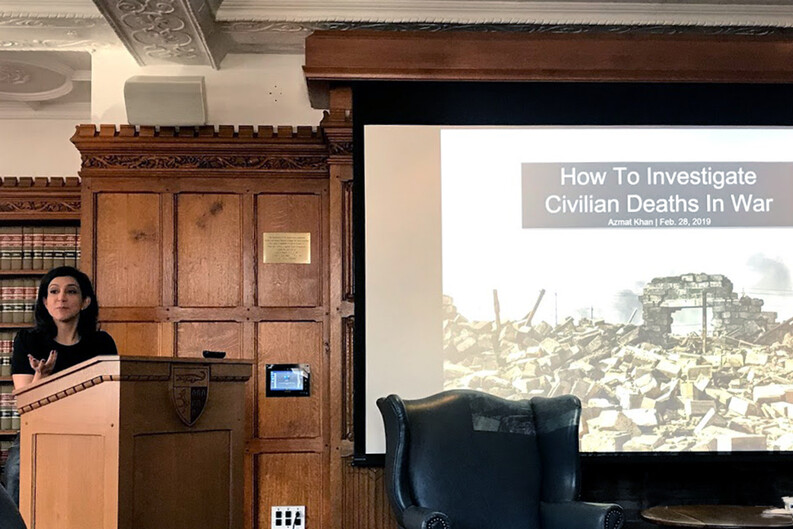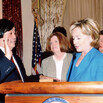Reporter Reveals How She Uncovered Hidden Civilian Death Toll in Iraq

In “The Uncounted,” a groundbreaking investigation in The New York Times Magazine, award-winning journalists Azmat Khan and Anand Gopal showed that the number of civilian casualties from U.S.-led airstrikes on ISIS strongholds in Iraq far exceeded the military’s reported figures. Khan told the story behind the investigation at the Human Rights Workshop on February 28, 2019, detailing how they gathered the information that led to the findings that they reported in the Times — that coalition-led airstrikes caused civilian deaths at a rate 31 times higher than officially acknowledged.
Khan and Gopal were some of the few journalists on the ground in Iraq during Operation Inherent Resolve, which began in 2014, putting them in a prime position to challenge the U.S. military’s claim that precise drone strikes minimized civilian casualties. They upended the military’s assertion with a combination of old-fashioned shoe-leather reporting and modern data collection.
The investigation began when Khan met civilians like Basim Razzo, whose house was bombed in a U.S. airstrike that killed his wife, brother, daughter, and nephew. The U.S. military had labeled his house a car-bomb factory based on an hour of drone footage. Personal stories from Razzo and others fueled Khan and Gopal’s narrative, which they backed with sophisticated data analysis.
Khan wanted to find out how regularly civilian homes became collateral damage or were targeted on false grounds in airstrikes focusing on three geographic areas: Qayyarah, Shora, and Aden in Mosul. By using satellite imagery and technology such as MilGPS, conducting door-to-door interviews, and having munition remnants analyzed, she was able to determine whether ISIS had ever used the site and, if so, what its purpose had been. She was then able to work out whether these bombing sites could have been considered legitimate targets for the U.S. military.
“If there were a target nearby, that would suggest [the military] was trying to hit it and missed the target,” she said. “If there weren’t, that would raise questions like, did [the military] have the wrong intelligence? Were they going after something they thought was something else?”
During the investigation, Khan would periodically present her data to the U.S. military. Its response, according to Khan, revealed that the U.S. military was not tracking its airstrikes properly. She uncovered that the U.S. military would “carry out four airstrikes in 15 minutes and only classify one in their logs,” she said. In other words, the military did not keep track of every airstrike made. Yet, despite its incomplete information, officials would refute her statistics by insisting that no airstrikes were carried out in that geographic area.
The military coalition said that one in 157 strikes had resulted in a civilian death. In contrast, Khan and her colleagues found that in the areas they sampled, “that number was one in five — and those were areas that were less likely to have civilian deaths than, say, Mosul or Raqqa, where the rates were highest.”
The U.S. military maintained that the majority of civilian casualties were instances of collateral damage in airstrikes that hit legitimate targets. But Khan’s data showed that this was only true for about a third of civilian casualties. Of the rest of civilian casualties, 13 percent were the result of the military trying and failing to hit legitimate targets. Half of the casualties were a result of the military receiving and making decisions based on poor or outdated intelligence, according to Khan’s data.
Khan contended that the U.S. military had failed to keep up with ISIS’s movements. “You can’t actually understand any of the facts unless you’re on the ground,” she said.
Khan also concluded that the military’s system of compensating civilians for their losses was “broken.” For instance, Razzo’s material possessions destroyed in the airstrike were valued at $400,000. The military offered him $15,000 for his damages.
Khan described some of the challenges she faced conducting interviews with Razzo and other relatives or friends of those who had died in airstrikes. “Asking people to relive the worst moments of their life,” she reflected, “that doesn’t feel good no matter what you say.” She stressed that she explained to her civilian sources that the only benefit of talking to her was to share their stories with a larger audience and that she would stop interviewing them if they ever felt uncomfortable. “But no one ever turned me away,” she said. “For many, it’s re-traumatizing to talk about it. But some people find therapy in it.”
When asked about the utility of human rights in her investigation, Khan said that it wasn’t her approach to advocate for victims by arguing that their deaths were violations of human rights law, and that many other human rights organizations were doing that job. “I didn’t deal with the question of whether these were war crimes,” she said. “Most of these deaths were legal under human rights structures.” This reality, she added, reveals deficiencies in the way we conceive of international humanitarian law.
After Khan’s investigation was published, Congress included clauses in a military spending bill that designated a senior official to devise processes for better tracking of civilian casualties, offering payments to injured civilians, and more. But Khan expressed doubts that this had changed anything. In fact, she said, “the military is releasing less information than before.” She did not claim that her investigation would halt the use of drone strikes.
“There’s very little to challenge airstrike campaigns as the model of the future,” she said. “The military knows that their power is strongest when the public doesn’t really know we’re at war. The more you have war conducted via airstrikes — where you don’t feel those losses or see those deaths or troops on the ground — the more power they have.”


